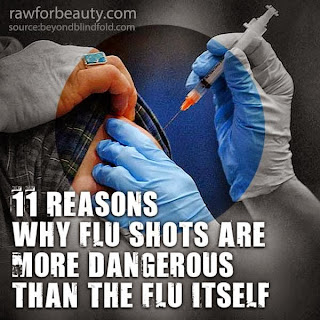And just in time, what did I see posted on one of my friends' facebook wall recently? This:
 |
The website goes on to list 11 sentences full of crap, in my opinion. But then again, I only worked in the Virology field for 6 years... I was happy that my friend, Tina, who has been working in the virus and vaccine development field for much, much longer, did not take this sitting down. With her permission, I am copying her response with a few comments of my own.
False Claim 1. The flu shot actually makes you sick to begin with
Tina the Virologist: The SHOT contains dead virus, it is impossible to give you the flu.
Me: To expand a bit, you cannot get flu from the shot because the vaccines contain either 'inactivated' (dead) virus or has no flu virus at all. You may mistake the sore arm and slight fever after the shot as flu, but this is caused by your immune system's response to the vaccine. Now, if you're absolutely sure that you got the flu when you just got the flu shot, then you probably have been exposed to the flu prior to the shot or during the 2-week period after the shot that the body is still gaining protection. Otherwise, you could have been exposed to a strain that is not included in the seasonal flu vaccine.
False Claim 2. Flu vaccines contain other dangerous ingredients such as mercury
Tina the Virologist: Multidose flu shots contain thimerosal, an organic mercury compound. This is much different than elemental or methylmercury, and is excreted from the body quicker. There is more mercury in breastmilk and tuna sandwiches than in the flu shot. And guess what? Single-dose flu shots are mercury-free, you can request those (these are given to pregnant women and children).
False Claim 3. The flu shot can cause Alzheimer’s disease
Tina the Virologist: NO. Just NO. In fact, those vaccinated against flu (among other things) are less likely to get Alzheimer’s. http://www.ncbi.nlm.nih.gov/pmc/articles/PMC81665/
Tina the Virologist: Even if they are how is this relevant to vaccine safety?
Me: I am pushing for flu vaccine, and I assure you I am not a billionare. Perhaps I should push harder?
False Claim 5. Lack of real evidence that young children even benefit from flu shots
Tina the Virologist: My search of www.pubmed.gov says otherwise…. Lots of studies have been done.
False Claim 6. Makes you more susceptible to pneumonia and other contagious diseases
Tina the Virologist: FALSE. It helps prevent influenza-associated pneumonia.
False Claim 7. Vascular disorders
Tina the Virologist: Muscle ache/pain at site of injection. Pretty obvious as to why, since you are sticking a needle in your muscle! Some people get a low-grade fever after the shot.
False Claim 8. Children under the age of 1 are at risk
Tina the Virologist: Yes, they are at risk from the FLU! Especially premature infants whose lungs are still playing catch-up developmentally. The H1N1 “swine flu” of 2009 was responsible for 282 US pediatric deaths. Last year’s flu killed 164. http://gis.cdc.gov/GRASP/Fluview/PedFluDeath.html
Me: I'm getting my 8 month old vaccinated on her next well-check.
False Claim 9. Increased risk of narcolepsy
Tina the Virologist: This is true for those of Northern European descent who got the European version of the H1N1 vaccine (which is a different formulation than the vaccine in the USA). Studies in the USA and Australia showed no correlation with narcolepsy.
False Claim 10. Weakens immunological responsesTina the Virologist: FALSE. Vaccines work by giving your immune system a “heads up” so they can quickly recognize the virus/bacteria and destroy it before you get sick.
False Claim 11. Serious neurological disordersIn 1976 a significant number of those who received the flu vaccine acquired Guillain-Barré Syndrome (GBS), a disorder characterized by permanent nerve damage and even paralysis.
Tina the Virologist: There was a higher than baseline GBS incidence with this batch of flu vaccines, but not in the batches since.
False Claim 11a. Flu vaccines can contain many harmful materials including detergent, mercury, formaldehyde, and strains of live flu virus.Tina the Virologist: Your body makes formaldehyde every day, the small amount added with the flu shot is not harmful. Flu shots DO NOT contain live virus, but the nasal flu spray (FLUMIST) does. It is a “broken” virus aka attenuated so it doesn’t multiply in your body.
Me: And there you have it. My personal plea is this: If you have a hard time looking for credible reading materials, or understanding tables of data in scientific publication about vaccines, seek someone who can help.


